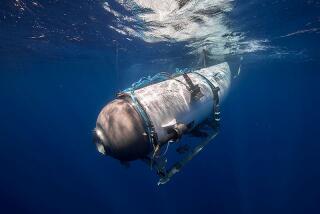No Place for Tourist Rides
The Navy’s inquiry into the Feb. 9 sinking of a Japanese trawler by the submarine USS Greeneville is expected to go on for several weeks, but key testimony has already exposed a root cause of the tragedy.
Had it not been for the presence aboard the sub of 16 civilian guests, the events that led to the ramming of the Ehime Maru off Hawaii almost certainly would not have occurred. Indeed, had it not been for the Navy’s interest in rewarding civilian supporters with VIP tours, the Greeneville would never have been at sea that day, and the deaths of nine Japanese could have been avoided. A purpose of the naval court of inquiry is to recommend changes in procedures. Barring visitors from the cramped confines of submarines at sea should be one.
Rear Adm. Charles Griffiths Jr., in charge of the initial investigation into the accident, cites a series of mistakes and omissions that contributed to the deadly encounter when the sub, conducting an emergency surfacing drill, smashed into the trawler from below.
The Greeneville was running 43 minutes behind schedule, which could have prompted its captain, Cmdr. Scott Waddle, to hurry preparations for the rapid ascent. Too little time--an estimated 80 seconds instead of the usual three minutes--was given to a periscope search for surface ships. A petty officer who should have been overseeing a trainee in the sonar room was instead detailed to act as a tour guide for the civilians. A sonar display that lets the commander and officer of the deck monitor surface vessels was broken. The enlisted technician who plots the location of surface ships detected by sonar somehow failed to notify appropriate officers that a contact had placed a ship within 2,000 yards of the sub.
The civilians on the sub, some of whom were allowed to manipulate certain controls under supervision, can’t be blamed for the collision. Yet there’s no doubt their presence contributed indirectly to what occurred. They were a distraction and they impeded communications among crew members. A lunch given them by Waddle ran long, causing subsequent procedures to be rushed. At least one key crew member was diverted from his task to show the guests around.
Waddle says he knows his career is over, no matter what the court of inquiry finds. But it wasn’t Waddle who initiated the Navy’s policy of inviting civilians aboard its ships. As Adm. Griffiths noted, Waddle was told by his superiors to entertain the visitors at sea and get them back in time for dinner.
The Greeneville was involved in a public relations excursion, not a training exercise. When the Navy assigns responsibility for the tragedy it should not overlook those who gave Waddle his orders.
More to Read
Sign up for Essential California
The most important California stories and recommendations in your inbox every morning.
You may occasionally receive promotional content from the Los Angeles Times.










